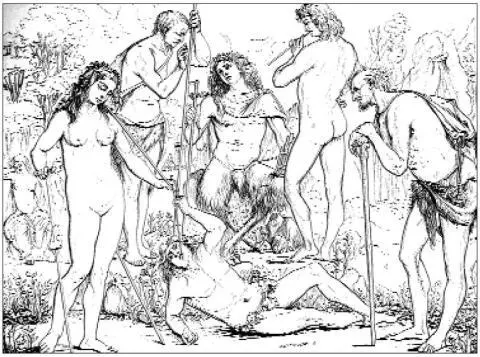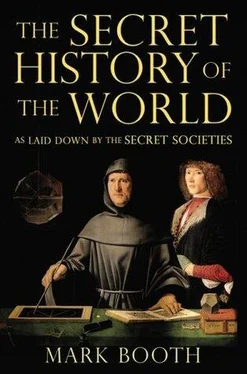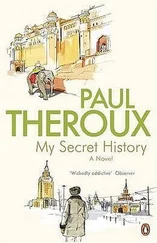The story of Osiris/Dionysius is the next and perhaps the most decisive stage in this process, when parts of the great cosmic mind, the universal consciousness, became parcelled off and absorbed into individual bodies. The bony roof of the skull hardened, closing over the Lantern of Osiris, so filtering out the great cosmic mind above.
According to the ancient wisdom, so long as there had been no barrier to the spirits, gods and angels ranged up above them, there had been no possibility of humans enjoying the individual free thought or will that distinguishes human consciousness. If we were not cut off from the spirit worlds and from the great cosmic mind, if our bodily make-up did not filter it out, our minds would be completely dazzled and overwhelmed.
Humans would now have some space for themselves in which to think.
The archetypal image of this model of the human condition is Plato’s Allegory of the Cave. Prisoners are chained in cave so that they face a wall and cannot look round. Events taking place outside the mouth of the cave throw shadows on to the wall that the prisoners take for reality.
This is an exposition of the philosophy academics call idealism, which holds that the cosmic mind and the thoughts or Thought-Beings emanating from it ( ideas ) are the higher reality. Physical objects, on the other hand, are mere shadows or reflections of this higher reality.
Because we are remote from the time when people believed in idealism, it is difficult for us to appreciate it as a living philosophy of life, rather than just as a dry as dust theory. But people who believed in idealism experienced the world in an idealistic way and also understood idealism as a historical process.
Academics tend to miss the surprisingly literal layer of meaning in Plato’s Allegory. The cave here is the bony roof of the skull. The skull is a dark, bony room covered in flesh.
Plato was an initiate and would have been well aware of the delicate mechanism of shadowing and reflecting that takes place inside the human skull, the occult physiology and psychology of the secret doctrine.
The defining characteristic of human life, its crowning achievement, and also the crowning achievement of the cosmos, is the capacity for thought. The brain is the most complex, the most subtle, altogether the most mysterious and miraculous physical object in the known universe.
According to the secret doctrine the cosmos created the human brain in order to be able to think about itself.
IT IS VITAL, IF WE ARE TO UNDERSTAND WHAT is happening here, to snap out of a materialistic way of thinking, to look at things, as it were, through the other end of the telescope. If you are an idealist, you believe that the universe was created by Mind for minds.
More particularly, you believe that the cosmic Mind created the material universe in order to give human minds the form they have.
The idealist history of creation is the history of this process, and the great events in this history have been the putting into place of the sun, moon, the planets and the stars. Our consciousness now has the structure it has because the heavenly bodies are ranged above us in the way they are.
With the moon in place to reflect the light of the sun down to earth and with this process reproduced in microcosm within the human skull, with matter having at last become sufficiently dense that the human mind is ‘closed off’, we have reached the point where human anatomy and human consciousness have achieved a form we would recognize today. The basic conditions making it possible for humans to reflect, that is to say, to think, were now in place.
There is, however, one more issue to consider.
IN THE SECRET HISTORY THERE IS ALSO A specifically sexual dimension to this development.
The Mystery priests believed that as the Lantern of Osiris withdrew underneath the bony covering of the skull and begun to occupy the position where we know it today as the pineal gland, the fleshly penis protruded. According to the ancient wisdom, the penis was the last part of the human body to assume its present, fleshly form, which is why artists in the secret societies, such as Michelangelo and, Signorelli, Leonardo’s brother initiate, often depicted the penis of the men of mythology as plant-like.
At this great turning point in history, then, just as the penis became flesh, humans could no longer propagate themselves by the old plant-like method of parthenogenesis. Humanity gave itself entirely over to animal sexuality.
And from this opens up a third and terrible dimension.

The Companions of Pan by Luca Signorelli. This engraving is a rare record of a painting destroyed during World War Two.
Human bones were hardening and becoming material. A human skull became something half-living and half-dead.
This is why it is an axiom of the secret doctrine that the beginning of death was the birth of thought .
According to the secret doctrine, there is a fundamental opposition between life and thought. The life processes in humans — digestion, respiration and the processes of growing, for example — are largely unconscious. The conscious, thoughtful dimension in humans is only made possible by a partial suppression of these life processes. The human organism ‘steals’ forces which in animals are used for growth and biological structuring, and channels them to create the conditions necessary for thought. It is said that this is one of the reasons why humans are, comparatively, sickly animals.
Human thought is a deadly process, restricting both growth and longevity.
When proto-humans were vegetable creatures, they did not experience death. When they began to take on animal characteristics, they began to experience a foretaste of death. This was an experience like dream-filled sleep. After a while they would ‘awake’ again into the material world. This sleep, even when it was very deep sleep, no longer gave humans the refreshment they craved. As human bones and the body of the earth hardened and rigidified to something near to what they are today, humans moved less freely, indeed painfully. The call of death grew louder and louder until it became almost overwhelming.
Sleep deepened until it became like death, and then it became death.
Now humans were finally entangled in the savage cycles of life, death and rebirth, cycles in which creatures must die in order to make way for a new generation. They now lived in a place where fathers must die to make way for sons, where the king must die to give way to a younger, more vigorous successor. Scholars have managed to piece together textual references with carvings at the Step Pyramid complex at Saqqara near Cairo in order to understand something of what must have happened at the ‘Heb-Sed’ rituals that took place there. Having undergone a Mystery school ceremony of death and rebirth in an underground chamber, the newly regenerated pharaoh would emerge into a more public courtyard. There he had to undergo a series of trials of strength and potency, including running with a bull, to try to prove that, as he would ritually cry, ‘I am free to run through the land’. If the pharaoh failed these tests he would suffer the same bloody death as the bull. The following eyewitness account, of a bull god sacrifice in India, comes from a nineteenth-century British traveller: ‘When the stroke is given which severs the head of the victim from his body, the cymbals strike up, the tom-toms beat, the horn is blown and the whole assembly, shouting, smear their bodies with blood, they roll themselves in it, and, dancing like demons, accompany their dances with obscene songs, allusions and gestures.’
Читать дальше













